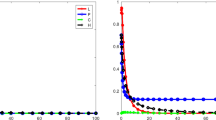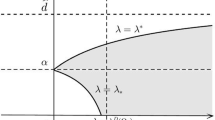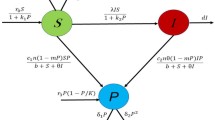Abstract
We consider a Lotka-Volterra prey-predator model with cross-diffusion and Holling type-II functional response. The main concern is the existence of positive solutions under the combined effect of cross-diffusion and Holling type-II functional response. Here, a positive solution corresponds to a coexistence state of the model. Firstly, we study the sufficient conditions to ensure the existence of positive solutions by using degree theory and analyze the coexistence region in parameter plane. In addition, we present the uniqueness of positive solutions in one dimension case. Secondly, we study the stability of the trivial and semi-trivial solutions by analyzing the principal eigenvalue of the corresponding linearized system, and then we characterize the stable/unstable regions of semi-trivial solutions in parameter plane.
Similar content being viewed by others
References
Amann H. Fixed point equations and nonlinear eigenvalue problems in ordered Banach spaces. SIAM Rev, 1976, 18: 620–709
Casal A, Eilbeck J C, López-Gómez J. Existence and uniqueness of coexistence states for a predator-prey model with diffusion. Differential Integral Equations, 1994, 7: 411–439
Dancer E N. On the indices of fixed points of mappings in cones and applications. J Math Anal Appl, 1983, 91: 131–151
Dancer E N. On positive solutions of some pairs of differential equations. Trans Amer Math Soc, 1984, 284: 729–743
Deuring P. An initial-boundary value problem for a certain density-dependent diffusion system. Math Z, 1987, 194: 375–396
Du Y H, Shi J P. Allee effect and bistability in a spatially heterogeneous predator-prey model. Trans Amer Math Soc, 2007, 359: 4557–4593
Dubey B, Das B, Hussain J. A predator-prey interaction model with self and cross-diffusion. Ecological Modelling, 2001, 141: 67–76
Freedman H I. Deterministic Mathematical Models in Population Ecology. New York: Marcel Dekker Inc., 1980
Gui C, Lou Y. Uniqueness and nonuniqueness of coexistence states in the Lotka-Volterra competition model. Comm Pure Appl Math, 1994, 47: 1571–1594
Guo G, Wu J. Multiplicity and uniqueness of positive solutions for a predator-prey model with B-D functional response. Nonlinear Anal, 2010, 72: 1632–1646
Guo G, Wu J. The effect of mutual interference between predators on a predator-prey model with diffusion. J Math Anal Appl, 2012, 389: 179–194
Kan-on Y. Stability of singularly perturbed solutions to nonlinear diffusion systems arising in population dynamics. Hiroshima Math J, 1993, 23: 509–536
Kindlmann P. Stability V S. complexity in model competition communities. In: Lecture Notes in Biomath, vol. 54. Berlin: Springer, 1984, 193–207
Ko W, Ryu K. Qualitative analysis of a predator-prey model with Holling type II functional response incorporating a prey refuge. J Differential Equations, 2006, 231: 534–550
Ko W, Ryu K. Coexistence states of a predator-prey system with non-monotonic functional response. Nonlinear Anal Real World Appl, 2007, 8: 769–786
Ko W, Ryu K. A qualitative study on general Gause-type predator-prey models with constant diffusion rates. J Math Anal Appl, 2008, 344: 217–230
Ko W, Ryu K. Analysis of diffusive two-competing-prey and one-predator systems with Beddington-Deangelis functional response. Nonlinear Anal, 2009, 71: 4185–4202.
Kuto K. Stability of steady-state solutions to a prey-predator system with cross-diffusion. J Differential Equations, 2004, 197: 293–314
Kuto K. Bifurcation branch of stationary solutions for a Lotka-Volterra cross-diffusion system in a spatially heterogeneous environment. Nonlinear Anal Real World Appl, 2009, 10: 943–965
Kuto K, Yamada Y. Multiple coexistence states for a prey-predator system with cross-diffusion. J Differential Equations, 2004, 197: 315–348
Kuto K, Yamada Y. Positive solutions for Lotka-Volterra competition systems with large cross-diffusion. Appl Anal, 2010, 89: 1037–1066
Leung A, Fan G. Existence of positive solutions for elliptic systems-degenerate and nondegenerate ecological models. J Math Anal Appl, 1990, 151: 512–531
Leung A W. Nonlinear Systems of Partial Differential Equations. Hackensack, NJ: World Scientific Publishing, 2009
Li L. Coexistence theorems of steady states for predator-prey interacting systems. Trans Amer Math Soc, 1988, 305: 143–166
Lin Z, Pedersen M. Coexistence of a general elliptic system in population dynamics. Comput Math Appl, 2004, 48: 617–628
López-Gómez J. Positive periodic solutions of Lotka-Volterra reaction-diffusion systems. Differential Integral Equations, 1992, 5: 55–72
Lou Y, Ni W M. Diffusion, self-diffusion and cross-diffusion. J Differential Equations, 1996, 131: 79–131
Lou Y, Ni W M. Diffusion vs cross-diffusion: an elliptic approach. J Differential Equations, 1999, 154: 157–190
Lou Y, Ni W M, Wu Y P. On the global existence of a cross-diffusion system. Discrete Contin Dyn Syst, 1998, 4: 193–203
Mimura M. Stationary pattern of some density-dependent diffusion system with competitive dynamics. Hiroshima Math J, 1981, 11: 621–635
Mimura M, Kawasaki K. Spatial segregation in competitive interaction-diffusion equations. J Math Biol, 1980, 9: 49–64
Nakashima K, Yamada Y. Positive steady states for prey-predator models with cross-diffusion. Adv Differential Equations, 1996, 1: 1099–1122
Nie H, Wu J H. Multiplicity and stability of a predator-prey model with non-monotonic conversion rate. Nonlinear Anal Real World Appl, 2009, 10: 154–171
Okubo A, Levin S A. Diffusion and Ecological Problems: Modern Perspectives, 2nd ed. New York: Springer-Verlag, 2001
Pao C V. Strongly coupled elliptic systems and applications to Lotka-Volterra models with cross-diffusion. Nonlinear Anal, 2005, 60: 1197–1217
Ruan W H. Positive steady-state solutions of a competing reaction-diffusion system with large cross-diffusion coefficients. J Math Anal Appl, 1996, 197: 558–578
Ryu K, Ahn I. Positive coexistence of steady states for competitive interacting system with self-diffusion pressures. Bull Korean Math Soc, 2001, 38: 643–655
Ryu K, Ahn I. Coexistence theorem of steady states for nonlinear self-cross diffusion systems with competitive dynamics. J Math Anal Appl, 2003, 283: 46–65
Ryu K, Ahn I. Positive steady-states for two interacting species models with linear self-cross diffusions. Discrete Contin Dyn Syst, 2003, 9: 1049–1061
Shigesada N, Kawasaki K, Teramoto E. Spatial segregation of interacting species. J Theoret Biol, 1979, 79: 83–99
Wang M, Wu Q. Positive solutions of a prey-predator model with predator saturation and competition. J Math Anal Appl, 2008, 345: 708–718
Yamada Y. Positive solutions for Lotka-Volterra systems with cross-diffusion. In: Handbook of differential equations: Stationary partial differential equations, vol. 6. Amsterdam: Elsevier/North-Holland, 2008, 411–501
Zhang C, Yan X. Positive solutions bifurcating from zero solution in a Lotka-Volterra competitive system with crossdiffusion effects. Appl Math J Chinese Univ Ser B, 2011, 26: 342–352
Zhang G, Wang W, Wang X. Coexistence states for a diffusive one-prey and two-predators model with B-D functional response. J Math Anal Appl, 2012, 387: 931–948
Zhou J, Mu C. Coexistence states of a Holling type-II predator-prey system. J Math Anal Appl, 2010, 369: 555–563
Author information
Authors and Affiliations
Corresponding author
Rights and permissions
About this article
Cite this article
Zhou, J., Kim, CG. Positive solutions for a Lotka-Volterra prey-predator model with cross-diffusion and Holling type-II functional response. Sci. China Math. 57, 991–1010 (2014). https://doi.org/10.1007/s11425-013-4711-0
Received:
Revised:
Accepted:
Published:
Issue Date:
DOI: https://doi.org/10.1007/s11425-013-4711-0
Keywords
- Lotka-Volterra prey-predator model
- Holling type-II functional response
- cross-diffusion
- positive solutions
- coexistence
- uniqueness
- degree theory




